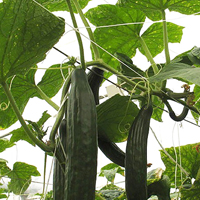Plant support netting enhances space utilization effici […]
Plant support netting enhances space utilization efficiency primarily by enabling vertical growth, which optimizes the use of available growing space. Here's a closer look at how plant support netting achieves this efficiency:
1. Vertical Growth: Traditional plant growth often follows a horizontal pattern, with sprawling vines or wide-spreading branches taking up substantial ground space. In contrast, plant support netting encourages plants to grow upward, vertically. This vertical growth minimizes the plant's footprint on the ground, allowing for the cultivation of more plants in the same area.
2. Increased Plant Density: By training plants to grow vertically, you can position them closer together without overcrowding or shading one another excessively. This increased plant density within a given space results in higher yields from the same plot of land or growing area.
3. Efficient Use of Resources: When plants grow vertically using support netting, resources such as water, nutrients, and sunlight are utilized more efficiently. Each plant has better access to essential resources, reducing competition among neighboring plants. This efficiency leads to healthier and more productive crops.
4. Space-Saving in Limited Areas: In urban or small-scale farming, where available space is often limited, plant support netting is a game-changer. It allows growers to maximize the use of small spaces like balconies, rooftops, or small garden plots, effectively transforming these areas into productive growing spaces.
5. Better Airflow and Disease Prevention: Vertical growth facilitated by plant support netting improves air circulation around plants. Improved airflow helps to reduce moisture levels and minimize stagnant, humid conditions that can promote the development of fungal diseases. This contributes to healthier, disease-resistant plants.
6. Enhanced Sunlight Exposure: As plants are trained to grow upward, more leaves and branches are exposed to direct sunlight. This increased sunlight exposure boosts photosynthesis, leading to stronger, healthier plants and higher-quality yields. It's especially advantageous for crops that require ample sunlight for optimal growth.
7. Easier Maintenance: Plant support netting simplifies routine maintenance tasks like pruning, weeding, and pest control. With plants neatly organized and accessible, growers can efficiently care for their crops, saving time and effort.
8. Reduced Damage Risk: By keeping plants off the ground, plant support netting helps protect crops from potential damage caused by trampling, pests, or soil-borne diseases. This reduces crop losses and enhances the overall quality of the harvest.
9. Consistent Harvesting: Harvesting becomes more straightforward with plant support netting because the fruits, vegetables, or flowers are easily visible and accessible. Growers can easily monitor the development of their crops and pick them at the peak of ripeness.
In summary, plant support netting efficiently utilizes space by promoting vertical growth and enabling closer planting. This technology addresses the need for more productive and sustainable agriculture, especially in urban and limited-space environments. As agriculture continues to evolve to meet the demands of a growing global population, strategies like plant support netting play a vital role in optimizing land use and maximizing crop yields.



 WhatsApp:+8613626888261
WhatsApp:+8613626888261